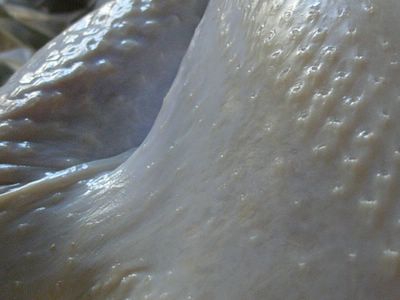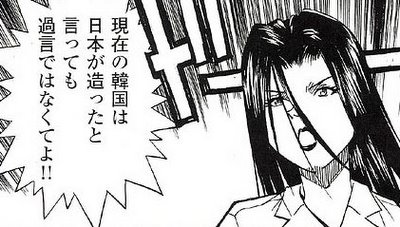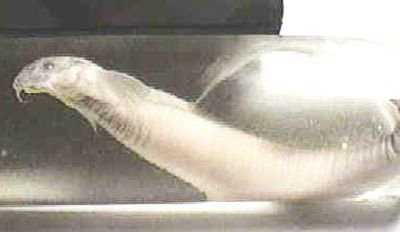
A: 까불지마! (nyuknyuknyuk)
Happy Thanksgiving!
stoking the embers of procrastination


By NORIMITSU ONISHI
In another comic book, "Introduction to
The two comic books, portraying Chinese and Koreans as base peoples and advocating confrontation with them, have become runaway best sellers in
In their graphic and unflattering drawings of
They also point to
Kanji Nishio, a scholar of German literature, is honorary chairman of the Japanese Society for History Textbook Reform, the nationalist organization that has pushed to have references to the country's wartime atrocities eliminated from junior high school textbooks.
Mr. Nishio is blunt about how
"I wonder why they haven't grown up at all," Mr. Nishio said. "They don't change. I wonder why
Mr. Nishio, who wrote a chapter in the comic book about
The reality that
The wave, though popular among Japanese women, gave rise to a countermovement, especially on the Internet. Sharin Yamano, the young cartoonist behind "Hating the Korean Wave," began his strip on his own Web site then.
"The 'Hate
"We weren't expecting there'd be so many," said Susumu Yamanaka, another editor at Shinyusha. "But when the lid was actually taken off, we found a tremendous number of people feeling this way."
So far the two books, each running about 300 pages and costing around $10, have drawn little criticism from public officials, intellectuals or the mainstream news media. For example, Japan's most conservative national daily, Sankei Shimbun, said the Korea book described issues between the countries "extremely rationally, without losing its balance."
As nationalists and revisionists have come to dominate the public debate in
"Lacking confidence, they need a story of healing," Mr. Yoshida said. "Even if we say that story is different from facts, it doesn't mean anything to them."
The
"It is
But the comic book, perhaps inadvertently, also betrays
That peculiar aesthetic, so entrenched in pop culture that most Japanese are unaware of it, has its roots in the Meiji Restoration of the late 19th century, when Japanese leaders decided that the best way to stop Western imperialists from reaching here was to emulate them.
In 1885, Fukuzawa - who is revered to this day as the intellectual father of modern Japan and adorns the 10,000 yen bill (the rough equivalent of a $100 bill) - wrote "Leaving Asia," the essay that many scholars believe provided the intellectual underpinning of Japan's subsequent invasion and colonization of Asian nations.
Fukuzawa bemoaned the fact that
Writing that "those with bad companions cannot avoid bad reputations," Fukuzawa said
As those sentiments took root, the Japanese began acquiring Caucasian features in popular drawing. The biggest change occurred during the Russo-Japanese War of 1904 to 1905, when drawings of the war showed Japanese standing taller than Russians, with straight noses and other features that made them look more European than their European enemies.
"The Japanese had to look more handsome than the enemy," said Mr. Nagayama.
Many of the same influences are at work in the other new comic book, "An Introduction to
The book describes
The book waves away
The book also says the Japanese Imperial Army's Unit 731 - which researched biological warfare and conducted vivisections, amputations and other experiments on thousands of Chinese and other prisoners - was actually formed to defend Japanese soldiers against the Chinese.
"The only attractive thing that
Like many in
"I have to thank
(From The New York Times, November 19, 2005)

It was also said that even if one caught the fish by the tail, once in the urethra it could not be pulled out because it would spread itself like an umbrella.
Because the fish spreads its gill covers in trying to get oxygen, the sharp spinous processes on the ends of the opercula engage the urethral wall making extraction from the urethra almost impossible or at least most traumatic.
When candirus parasitize humans, it is usually only when they are skinny-dipping while urinating in the water. The candiru tastes the urine stream and follows it back to the human. It then swims up the anus and lodges itself somewhere in the urinary tract with its spines. Blood is drawn, and the candiru gorges itself on both the blood and body tissue, its body sometimes expanding due to the amount of blood. This is all said to be very painful for the poor person who has this happen to him or her. Unfortunately, they are almost impossible to remove due to the spines. Amputation of the private areas is the cheapest, and most life-changing, way to remove the fish. Actual surgery is extremely expensive and involves inserting the Xagua plant and the Buitach apple up the urethra. These two plants kill and even dissolve the parasitic fish. If surgery is not done in time, the blockage of the urinary tract will prove fatal. The candiru is the only known vertebrate to parasitize humans. (link)